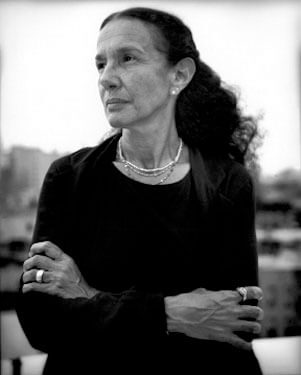Mary Ellen Mark is an American photographer known for her photojournalism, portraiture, and advertising photography. She has had 16 collections of her work published and has been exhibited at galleries and museums worldwide. She has received numerous accolades, including three Robert F. Kennedy Journalism Awards and three fellowships from the National Endowment for the Arts.
Mary Ellen Mark was born in suburban Philadelphia, Pennsylvania, and began photographing with a Box Brownie camera at age nine. She attended Cheltenham High School, where she was head cheerleader and exhibited a knack for painting and drawing. She received a BFA degree in painting and art history from the University of Pennsylvania in 1962, and a Masters Degree in photojournalism from that university's Annenberg School for Communication in 1964. The following year, Mark received a Fulbright Scholarship to photograph in Turkey for a year. While there, she also traveled to photograph England, Germany, Greece, Italy, and Spain.
In 1966 or 1967, she moved to New York City, where over the next several years she photographed Vietnam War demonstrations, the women's liberation movement, transvestite culture, and Times Square, developing a sensibility, according to one writer,
"away from mainstream society and toward its more interesting, often troubled fringes". As Mark explained in 1987,
"I'm just interested in people on the edges. I feel an affinity for people who haven't had the best breaks in society. What I want to do more than anything is acknowledge their existence".
Her shooting style ranges from a 2 ¼ inch format, 35 mm, and 4x5 inch view camera. She also uses a Leica 4 for most photographs and Nikons for long-range shooting. Mark loves shooting with a Hasselblad for square format and she shoots primarily in black-and-white, using classic Kodak Tri-X film.
Source: Wikipedia
Mary Ellen Mark achieved worldwide visibility through her numerous books, exhibitions and editorial magazine work. She published photo essays and portraits in such publications as
Life,
New York Times,
The New Yorker,
Rolling Stone, and
Vanity Fair. For over five decades, she traveled extensively to make pictures that reflect a high degree of humanism. She is recognized as one of our most respected and influential photographers. Her images of our world's diverse cultures have become landmarks in the field of documentary photography. Her portrayals of
Mother Teresa, Indian circuses, and brothels in Bombay were the product of many years of work in India. A photo essay on runaway children in Seattle became the basis of the academy award-nominated film
Streetwise, directed and photographed by her husband,
Martin Bell.
Mary Ellen received the 2014 Lifetime Achievement in Photography Award from the
George Eastman House as well as the Outstanding Contribution Photography Award from the World Photography Organisation. She has also received the Infinity Award for Journalism, an Erna & Victor Hasselblad Foundation Grant, and a Walter Annenberg Grant for her book and exhibition project on
America. Among her other awards are the Cornell Capa Award from the
International Center of Photography, the
John Simon Guggenheim Fellowship, the Matrix Award for outstanding woman in the field of film/photography, and the Dr. Erich Salomon Award for outstanding merits in the field of journalistic photography. She was also presented with honorary Doctor of Fine Arts degrees from her Alma Mater, the University of Pennsylvania and the University of the Arts; three fellowships from the National Endowment for the Arts; the Photographer of the Year Award from the Friends of Photography; the World Press Award for Outstanding Body of Work Throughout the Years; the Victor Hasselblad Cover Award; two Robert F. Kennedy Awards; and the Creative Arts Award Citation for Photography at Brandeis University.
She published twenty books including
Passport (Lustrum Press, 1974),
Ward 81 (Simon & Schuster, 1979),
Falkland Road (Knopf, 1981),
Mother Teresa's Mission of Charity in Calcutta (Friends of Photography, 1985),
The Photo Essay: Photographers at work (A Smithsonian series),
Streetwise (second printing, Aperture, 1992),
Mary Ellen Mark: 25 Years (Bulfinch, 1991),
Indian Circus (Chronicle, 1993 and Takarajimasha Inc., 1993),
Portraits (Motta Fotografica, 1995 and Smithsonian, 1997), a
Cry for Help (Simon & Schuster, 1996),
Mary Ellen Mark: American Odyssey (Aperture, 1999),
Mary Ellen Mark 55s (Phaidon, 2001),
Photo Poche: Mary Ellen Mark (Nathan, 2002),
Twins (Aperture, 2003),
Exposure (Phaidon, 2005),
Extraordinary Child (The National Museum of Iceland, 2007),
Seen Behind the Scene (Phaidon, 2009),
Prom (Getty, 2012,)
Man and Beast (University of Texas Press, 2014,)
Tiny: Streetwise revisited (Aperture, 2015,) and
Mary Ellen Mark on the Portrait and the Moment (Aperture, 2015.) Mark's photographs have been exhibited worldwide.
She also acted as the associate producer of the major motion picture,
American Heart (1992), directed by,
Martin Bell.
Her last book
Tiny: Streetwise Revisited is a culmination of 32 years documenting Erin Blackwell, who she first met in 1983 on assignment for
Life Magazine. Erin was the subject of both the book and film
Streetwise. Martin also made an updated film,
Tiny: The Life of Erin Blackwell.
Aside from her book and magazine work, Mark photographed advertising campaigns among which are Barnes and Noble, British Levis, Coach Bags, Eileen Fisher, Hasselblad, Heineken, Keds, Mass Mutual, Nissan, and Patek Philippe.
Source: www.maryellenmark.com

